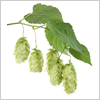
 World: June 2006 Hop Report by Douglas MacKinnon
World: June 2006 Hop Report by Douglas MacKinnon
It is too early to make predictions regarding the hop crop for 2006 other than to say that supply will be tight at best in some varieties. The hop crop in both the U.S. and Germany got off to a late start due to a colder than normal spring. Hops love the heat however and that late spring in the U.S. was followed by some above average temperature causing hop growth to be ahead of schedule at the time of this writing. German hops remain roughly one week behind schedule, but, as we have seen in the U.S., that can quickly change with several days of warm weather. The weather in August typically determines the hop crop in Germany. A hot August with little or no rain can send German yields plummeting as they did in 2003. Conversely, as was the case in 2004 and 2005, a warm and wet August can deliver excellent hops and alpha acid. The biggest problem at this time is hop powdery mildew, which although potentially devastating to a hop crop can be managed with pesticides.
The most recent news out of the U.S. is the acreage data listed in the following table. With acreage figures being the main newsworthy event, this appears to be a calm year in the hop world. One significant difference between 2006 in the U.S. and previous years is the fact that nearly all American hops are sold. Supply will be tight even if the crop produces average yields. If yields are low, there may be some shortages. Quite a few European hop varieties however are still available. One reason for the inequity between American and European hop sales is, of course, the weak dollar, which has made American hops relatively inexpensive on the world market. There has been little market activity recently although quite a few inquiries. What activity there has been confirms that prices for hops in general are on the rise with some hops already being impossible to obtain.
In short, there are many things that can happen to a hop crop between June and September, which is why most growers don’t feel safe estimating their crop until it is in the bale.
Douglas MacKinnon, former director of Hop Growers of America is chairman of the International Hop Growers Convention executive committee. He publishes the MacKinnon Report, a subscription newsletter that reports developments and market activity within the hop industry.
Comments are welcome via email at doug@mackinnonreport.com.
Related table:
"Hops: Area Harvested by Variety, State, and United States, 2004-2005 and Forecasted June 1, 2006"
10 kb, 1page, *.pdf file
Înapoi
(libra 0.8926 sec.)





